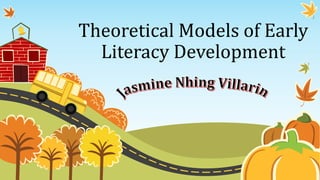
Villarin
- 1. Theoretical Models of Early Literacy Development
- 3. Bottom- up Print Awarenss Pre-readers must understand that the shapes and lines on a page represent letters and when put together, represent different words. Once students learn that print is read from left to right and top to bottom and that there are spaces between words, they can begin to understand that words in print convey meaning
- 4. Bottom- up Letters and Phonics Bottom-up teaching strategies help students learn letter recognition while developing print awareness. As they begin to recognize and identify letters, teachers begin developing students' phonetic awareness. Students then learn to pronounce common letter combinations, such as “th” or “st.”
- 6. Bottom- up Decoding and Practice Students begin decoding by sounding out each letter or letter combination in a word As they learn to read several simple words, students practice reading simple stories. They learn to sound out increasingly difficult material by sounding out letters in a word, one word at a time Though the decoding process can be slow at first, readers begin to automatically recognize some words. Over time, they are able to sound out new words more quickly.
- 7. Bottom- up Reading Fluency Reading fluently is the final step of bottom-up reading theories. Beginning readers might not understand much of what they are reading as they concentrate on decoding and pronouncing each word Once they are able to recognize words quickly, they begin to not only read text but improve comprehension, Fluency develops and improves over time, with practice and repetition
- 8. Top-down
- 9. The top-down model looks at the reader’s knowledge base and his or her ability to make predictions using this base. The reader has the use of the printed text only to confirm and/or generate new hypotheses. (Lipson & Wixson, 1991).
- 10. TOP-DOWN reading process is a reverse of the bottom-up model Readers use their background knowledge to make predictions as they read the text
- 11. PURPOSES OF TOP-DOWN encourages students to focus more on understanding the main ideas of a passage than understanding every word if students do not understand each word, they are likely to grasp the meaning of a text as a whole encourages students to rely on their own knowledge and use context clues to understand new concepts or words
- 12. allows students choose books to read based on their own interests New readers will begin to understand new vocabulary and increase reading fluency as they read engaging and interesting books Teachers will encourage readers to develop speaking and listening skills by reading aloud to the class or to a smaller group of students (http://everydaylife.globalpost.com/topdown-reading-model-theory-13028.html)
- 13. TOP-DOWN THEORIES IN THE READING PROCESS Learning how to read stories, sentences, or phrases is assumed to lead to a perception of the parts and their relationship to the whole text and meaning. Repeated readings of authentic books of interest with help or independently are assumed to lead to an ability to read fluently with comprehension.
- 16. FEATURES OF TOP-DOWN APPROACH Reading for meaning is the primary objective of reading, rather than mastery of letters, letters/sound relationships and words. Reading requires the use of meaning activities than the mastery of series of word- recognition skills. The primary focus of instruction should be the reading of sentences, paragraphs, and whole selections The most important aspect about reading is the amount and kind of information gained through reading.
- 17. TOP-DOWN EXERCISES Schema Activation - by building background knowledge, we can increase students' understanding of texts. Cultural and experiential knowledge gaps can create the impression of a language barrier, when it is simply that the student lacks the appropriate schema.
- 18. Interactive
- 19. Interactive • Unlike other theories, the interactive reading theory addresses, more than just the text being used. It focuses on the reader’s interactions with the text, and the three elements in the reading process. • First the author’s purpose for writing the text is identified prior to reading and during the process of reading the text. • Second, the theory addresses the actual text itself and how the author uses the text to talk to the reader. • Finally, the theory looks at how the reader constructs meaning from the text and makes connections to what they already know
- 20. huuhu